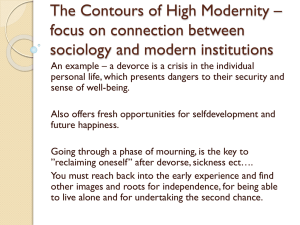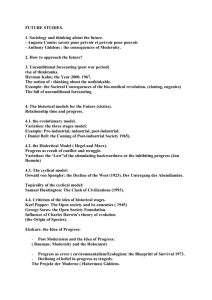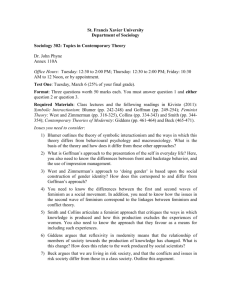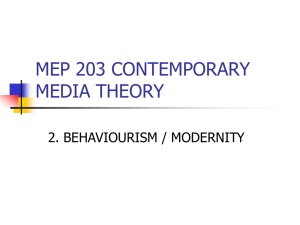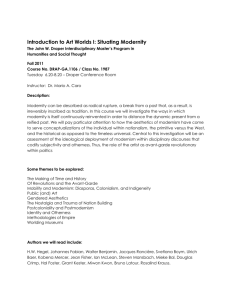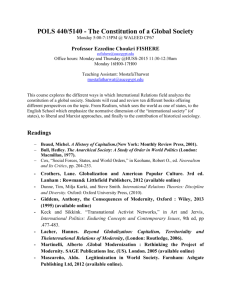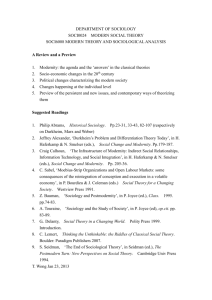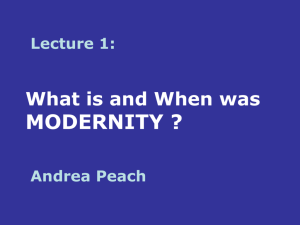Religious participation test *
advertisement
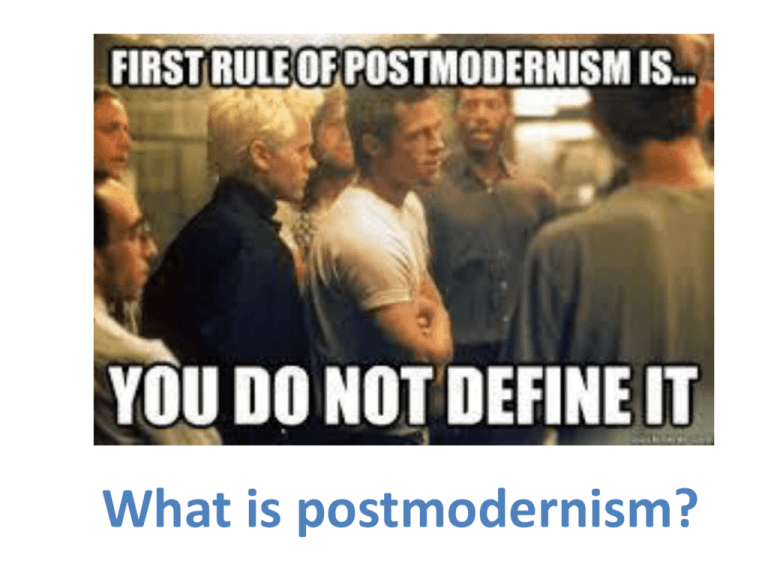
What is postmodernism? A perspective that refers to a particular time period (epoch) Feudalism Modernity Late modernity Postmodernity Feudalism • Monopoly of the truth • Singular understanding of the world • Hierarchical structure Modernity • Rationalization – the enlightenment • Differentiation How has the world changed in the last few decades? Late modernity - Giddens Late modernity - Giddens 1. Reflexivity – uncertainty – constant monitoring of social life to try and improve it. A tendency to undermine the traditional • Sociology is part of this reflexivity How does this apply to religion? Most of the situations of modern social life are manifestly incompatible with religion as a pervasive influence upon day to day life. Religious cosmology is supplanted by reflexively organised knowledge, governed by empirical observation and logical thought, and focused upon material technology and socially applied codes. Religion and tradition were always closely linked, and the latter it even more thoroughly undermined than the former by the reflexivity of modern social life that stands in direct opposition to it. Late modernity - Giddens • Separation of time and place – new and digital media means that we are communicating with people across the world and not face to face WHAT EFFECT MIGHT THIS HAVE ON RELIGION? Late modernity - Giddens • Disembedding – people are affected by things that happen a long way away WHAT EFFECT MIGHT THIS HAVE ON RELIGION? Late modernity - Giddens Despite the apparent incompatibility with religion, Giddens argues that the resurgence of religion in some places is understandable. Why might the following aspects of late modernity help religion to grow or at least survive in a late modern world? - Uncertainty - Individual freedom and choice - The reflexivity of science Late modernity - Giddens Fundamentalism has arisen in the last 40 years in response to late modernity and Giddens thinks that this is dangerous because it a late modern world there is much more ethnic diversity, so people need to be more tolerant of each other not less. Grace Davie – Believing without belonging • • • • Argues against the secularisation thesis Religion has become privatised Vicarious religion is taking place Canadian survey (1993) 25% attended regularly but 80% said they had religious beliefs. • BUT data suggests otherwise and Bruce makes point that if they are not acting on their beliefs, how strong are their beliefs? Danielle Hervieu-Leger • • • • Personal choice Believing without belonging Cultural amnesia – change in socialization Individual consumerism has replaced traditional institutional religion – we are SPIRITUAL SHOPPERS • Pilgrims and converts have emerged • Religion is not such a source of collective identity like before Zygmunt Bauman (1992)– Postmodernism • Similar to Giddens: • Postmodern world has arisen from modernity • Reflexivity has increased • Religious revival has arisen out of individual problems and need for meaning Zygmunt Bauman (1992)– Po-mo Po-mo: • Deconstructs claims for universal truth • People no longer accept authority • Freedom to be a ‘shopper’, to pursue anything • Uncertainity is something to be embraced • Individuals have no external rules to live their lives • Personal ethics and morality are the most important not external ones Individuals have many choices available to them – many look to experts - Some follow mass groups - Some look to religion - Some try to be trend setters James Beckford (1996) • Bauman is contradictory – why? • Beckford disagrees with the idea that there has been a religious revival because he does not think there was a preceeding massive decline. Stark and Bainbridge – religious market theory • Religion as compensation – religion meets our needs and also provides rewards • Cycle of religious decline, revival and renewal • Religion is a market place, when one religion declines it leaves a gap for another to fill it • Churches are like companies striving to improve their service and attract more customers Stark and Bainbridge – religious market theory • Competition between religious groups is a good thing because they are fighting to win customers – this is the case in the USA because of the constitution • In European countries such as Spain and Italy, Catholicism has had a monopoly which leads to decline • Supply creates demand not the other way round (televangelism) • Megachurches • Japan since WW2 has had a free market for religion and new religions have thrived as a result David Lyon – Jesus in Disneyland (2000) • Quite like Giddens and Bauman but: • Unlike Bauman he does not think pomo has supplanted modernity • Unlike Giddens he thinks that societies have moved beyond late modernity David Lyon – Jesus in Disneyland (2000) 1. New digital media – globalisation – choice of religions, spirituality etc…identities are less based on local communities 2. Growing consumerism – people are free to choose on their own what to do with their time, their homes, their bodies and their gods… David Lyon – Jesus in Disneyland (2000) 1. Religion is not necessarily declining – it has relocated to the sphere of consumption 2. People are less willing to accept the authority of the church but still seek meaning 3. Peoples identities are more fluid and open to personal choice 4. People still need narratives for their lives but are looking at other besides traiditonal ones David Lyon – Jesus in Disneyland (2000) 1. Canada: 75% don’t attend religious ceremonies regularly but 80% still draw upon religious beliefs and practices Shift from religious institutions to a cultural resource David Lyon – Jesus in Disneyland (2000) Harvest Day Crusade in California Several stages with Christian singers and for Lyon this was an example of religion interacting with the most postmodern of settings, Disneyland. Disneyland is seen as a very postmodern place because it is a fantasy world but many of the signs are treated as if they are – autographs from Mickey Mouse for example. Religion is no longer confined to traditional places, it is adapting David Lyon – Jesus in Disneyland (2000) De-differentiation The lines in society are becoming blurred. Religion and popular culture. Paul Heelas – Postmodernity and new age movements There are many ways new age movements can be considered postmodern: 1. Dedifferentiation – difference is not acknowledged 2. Relativism – NAMs don’t claim that there is one set of ideas that reveal the whole truth 3. Consumers of different NAMs 4. Experience is emphasised over achievement Paul Heelas – Postmodernity and new age movements But Heelas says they are not postmodern: -the New Age has a very strong metanarrative at its heart. Although it rejects cultural metanarratives it has replaced them with experiential metanarratives. - The New Age is part of modernity – importance of individualism
